Search Engine Optimization (SEO) is one of those things a lot of startups wish they had started earlier. Initially, people think “you can do it later,” “it doesn’t scale,” “it costs too much time,” and “it’s spammy.”

Once they reach a certain point they realize that they have been missing out on SEO the whole time. SEO is now at a place where it’s indispensable for a company, especially for startups.
It facilitates the three most important goals for a startup:
Scaling customer acquisition, Finding product market fit faster (the moment product fits exactly to a market’s demand and you see exponential growth), Controlling reputation.In this article, I will address why SEO for startups is integral, how they lose time and money without it, the best and worst practices, and give you hands-on tips for success.
Steps to Improve SEO for Startups
1. Build the Right Reputation in the Search Results 2. Find and Control Threats to Your Product 3. Accelerate the Authority of Your Startup 4. Scale User Acquisition Exponentially 5. Focus On the Right SEO Opportunities1. Build the Right Reputation in the Search Results
Leading with a strong online presence will allow people to find you more easily, better understand what you do, and get to know who you are. All of these will improve your chances to get funded. Do you really think VCs invest even a dime into your company without stalking the heck out of it? Exactly!
Your website will have many purposes, but from an investor standpoint of view it has to:
Clearly explain what you do.
Show your product or a prototype — ideally, live.
Tell your story. (who are you, what is your mission, and how are you going to achieve it?)
In other words, your website should clearly define your brand. However, your brand doesn’t just live on your website. That is why you have to think about your brand in a larger sense, especially in terms of its Google search results (SERPs).
Here is an example of something you don’t want to see on the first page of google search results for your brand:

If the first search result is negative, that can negatively impact your brand. According to SEMrush there are over 5.2 Million global searches for “Uber” every month. Quite the attention! A lot of people might see the article above and be less inclined to take Uber. It is a direct threat to your reputation, and as a startup, that can kill you.
You need to build a defense that pushes negative results further down to where nobody can see them. That means, a) building a presence on other sites that rank for your brand and b) creating assets on your own site that you can control.
Some assets you can control:
Social media accounts*
Directories (such as Crunchbase, Wikipedia, AngelList, etc.)
App stores (iTunes, Play Store)
Your Blog
Microsites (more about that a little further down)
List of assets you can influence:
Forums (such as Reddit)
List of assets you cannot control:
Google news (integration for your brand)
Coverage from other publishers
*I advise against setting accounts up and then not maintaining them. You should at least put up a minimum effort to avoid “ghost towns”. Abandoned social media profiles look unprofessional.
You even want to consider how your brand comes across in the search results already before you pick a name for your company. If it is too generic you might have trouble showing up on top of the search results because your brand competes with results from Wikipedia (largest website in the world), dictionary.com (9th largest website), and others.
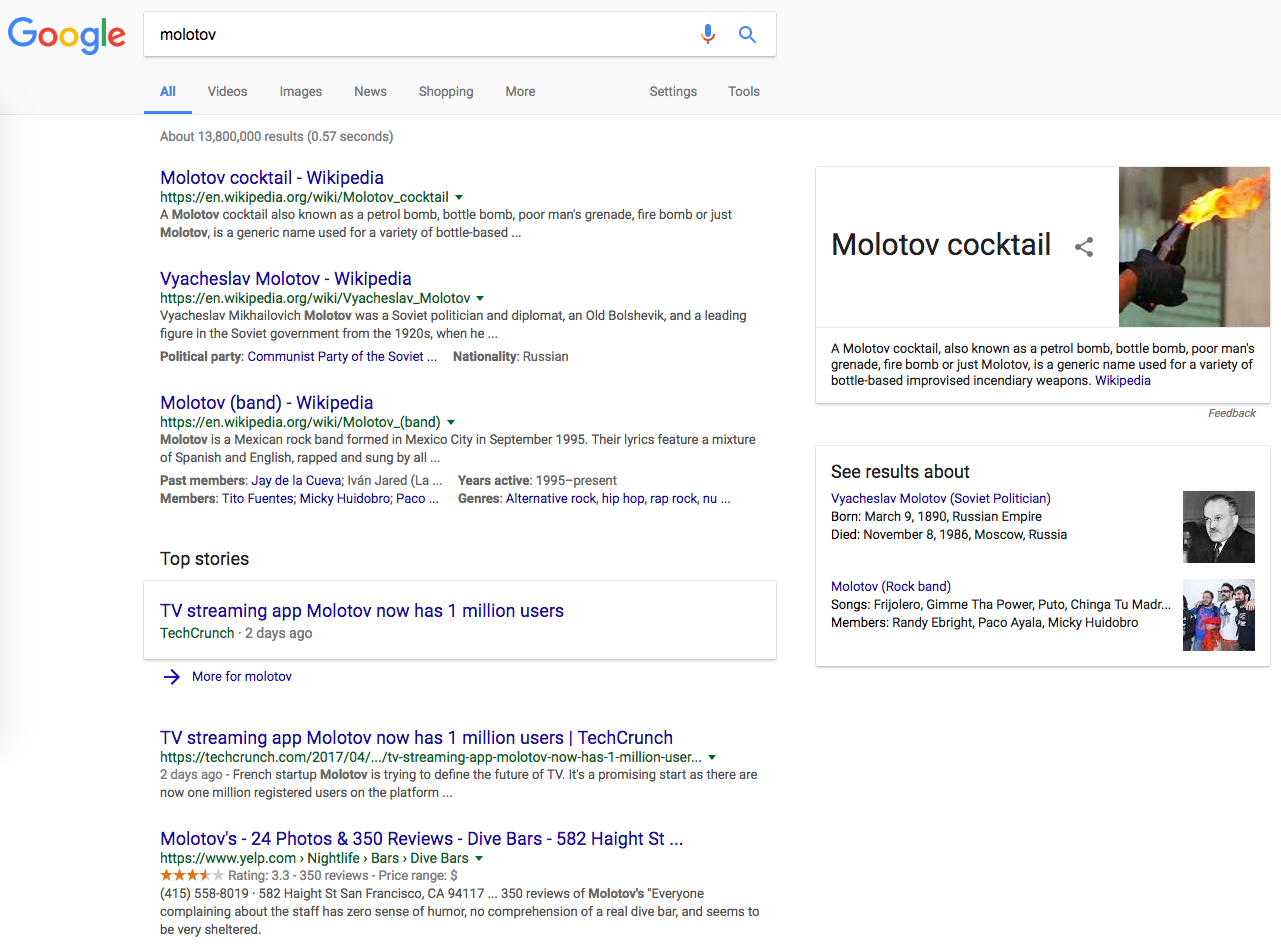
It is not impossible to rank higher than those platforms, but why make it so difficult in the beginning? Building your defense doesn’t stop here.
2. Find and Control Threats to Your Product
After brand searches, comparison queries are the second biggest threat to your brand. It is when users search for “[brand] alternative” or “[brand 1] vs [brand 2]”.
When users compare your product against others, they are in either one of two stages in the user journey: at the beginning or at the end. They either consider coming on board or jumping ship. Whatever stage they are in, you need to guide their decision.
It is very important for you to be very present to users at this stage so you can show them how your product is the best on the market.
Let’s look at the example “Uber vs. Lyft”:
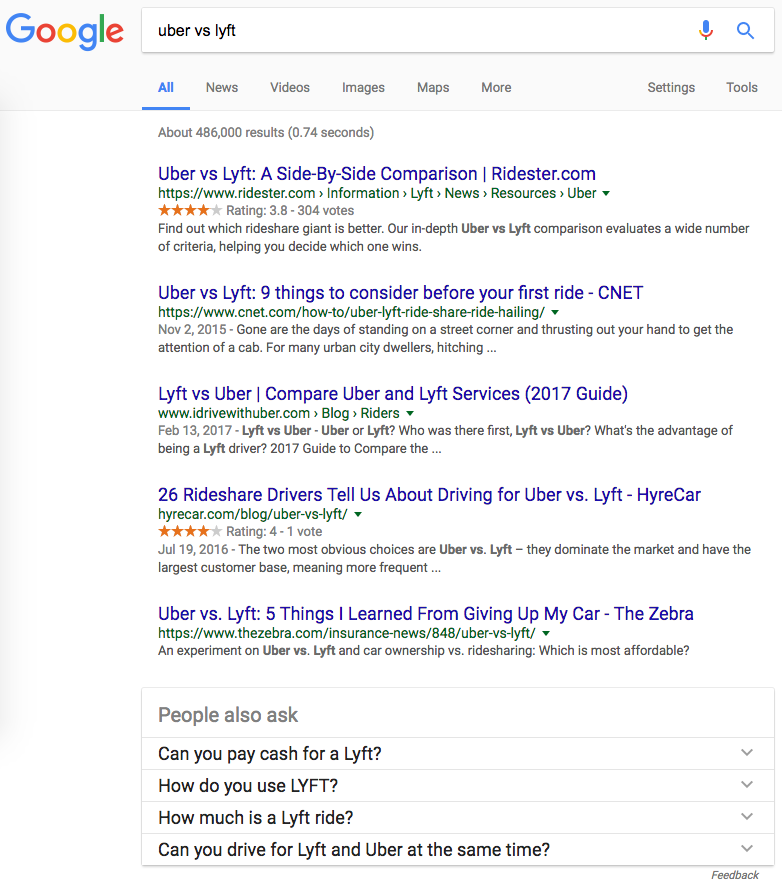
Neither Uber nor Lyft has built a landing page to address these queries — a missed opportunity if you ask me. I know, as SEOs we often get lost in the technicalities, but we must not become blind about how our users might see our brand.
Google Suggest tells you who users are comparing your brand to.

Create one landing page for every “vs. query” and address your unique USPs over your competitor. Long-form and structured content work wonders on these pages.
“Alternative” queries are pretty much the same thing.
SEO can help you find the websites and platforms users are discussing your brand on. When you google “Postmates alternative” you can see someone got a position 0 spot for it, and People Also Ask is ranking above search results.
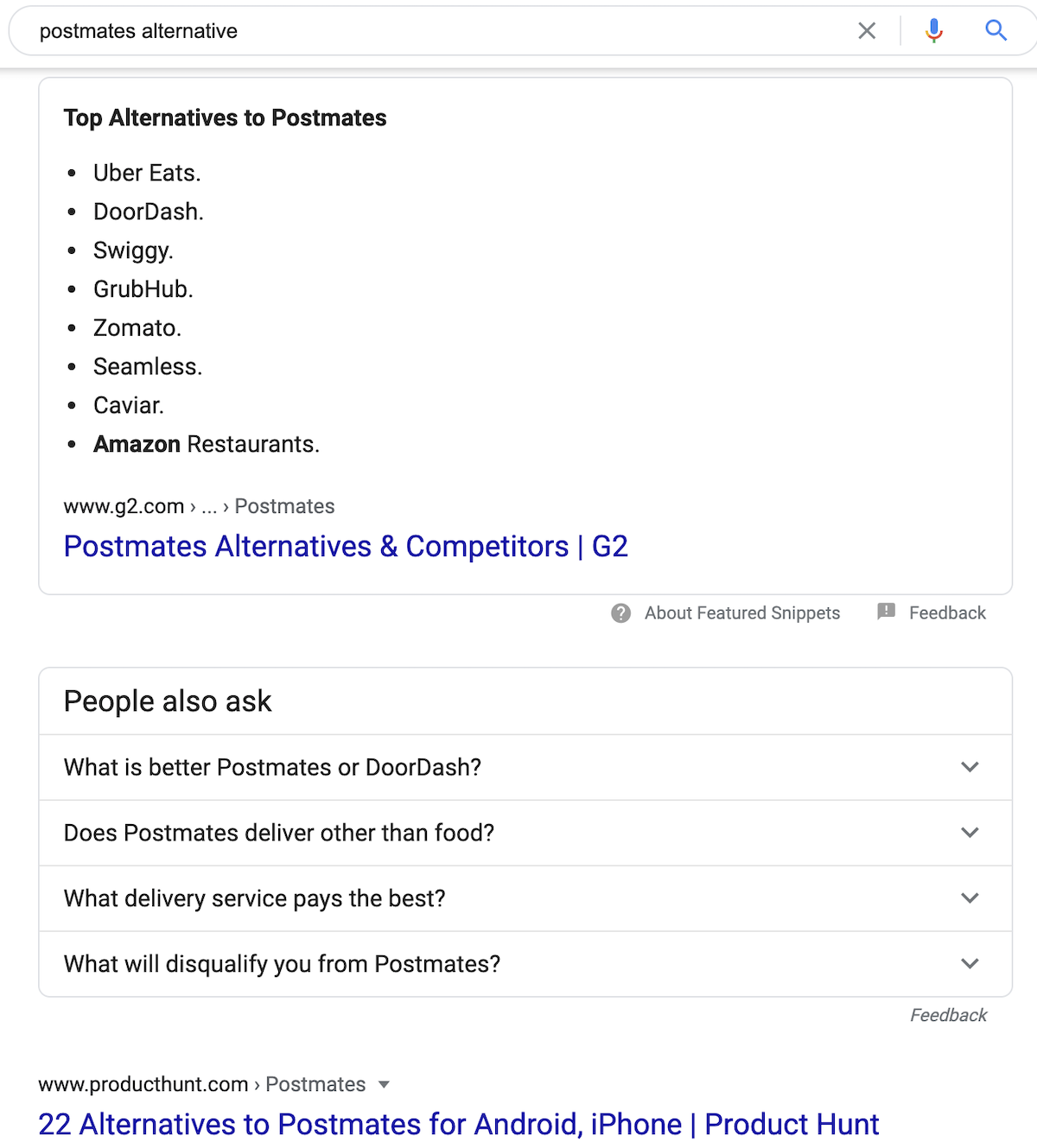
We can also see that conversations on Reddit have ranked in the top 10:
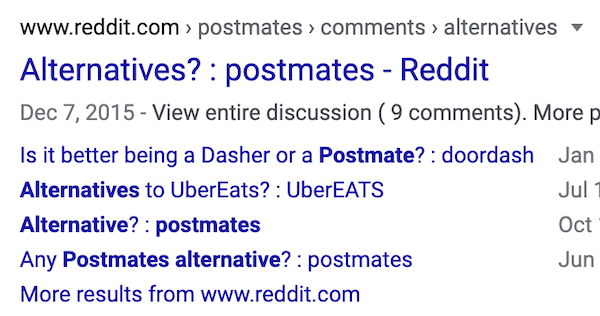
You need to see what is being written and where conversations are happening; learn from both. Whether you then join in on the discussions or build assets on your website is up to you. Tracking brand mentions is a great idea to make sure you are catching all discussions and articles.
A common fallacy is to think that if you don’t address a conversation it won’t happen. But in reality, the conversion will happen, with or without you.

The only scenario, in which you should let a third party inform users about choosing your or your competitor’s product, is when you can influence that third party to report in your favor.
In this case, it can actually be more powerful than owning the result yourself.
Researching these queries helps you to identify new competitors you might not have seen coming. As a startup, it makes sense to invest time into this. Nothing is worse than waking up one day and realizing someone came out of nowhere and is now miles ahead of you.
This is where SEO becomes part of market research. You need to understand your market from the inside-out. How else can you achieve and keep product-market fit?

Finding negative questions about your product is the last missing piece to your defense brick wall. Finding what negative questions people have about your product helps you to improve your product and influence the conversation about it. Tools like SEMrush's Topic Research tool allow you to find questions people are asking in real-time; be the one to answer them.
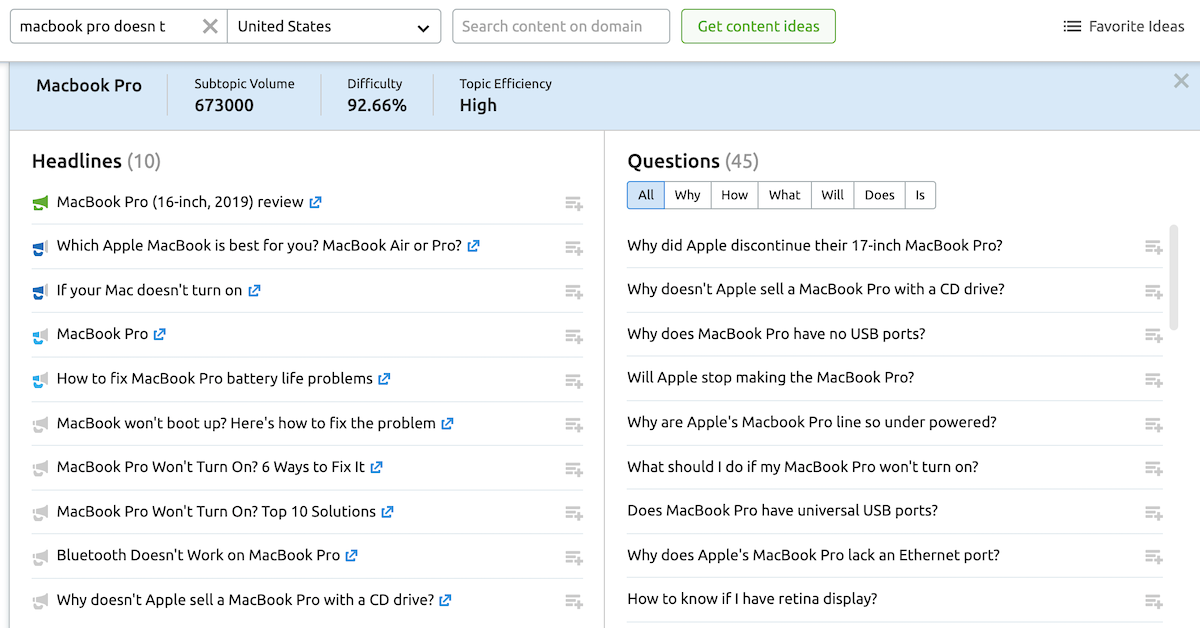
Once you did your research, you proceed the same way we discussed in this chapter: create content that addresses it.
3. Accelerate the Authority of Your Startup
Authority is one of the two most important principles in SEO and without pursuing it, startups can’t win the long game. The other principle is relevancy (more in chapter 4), but the actual question is: how do you build authority? And the answer is — backlinks.
Backlinks got a terrible reputation over the last years because so many people tried to game the system to get an unfair advantage, which Google punished mercilessly. What many people ignore is that they’re still the backbone of Google’s algorithm. Every startup should think about backlinks, just not in an aggressive way. In 2017, we need to earn links.
Backlink Principles to Remember
If I wrote down a step-by-step process it would be copied too much. Therefore, I will give you the framework. Principles over tactics. The mindset you should embrace is to strive for a “natural” backlink profile. So the question is “what is a natural backlink profile for a startup?”.
The answer is simple: a backlink profile seems natural to Google if it grows at the right pace and has the right ratios. Pace means how many new links do you gain and how many do you lose over a given time, say a week. Ratios, in this context, mean the relation between Nofollow and Follow links, backlink types (text, images, redirect), TLDs & country, hard vs. brand anchor text, and of course, the authority of the linking sources.
Backlink Analysis
It is important to analyze your own and your competitor’s profile because optimal backlink profiles are different from industry to industry. Once you know what the profile of your top 5 competitors looks like, you can develop a strategy to earn the links you need, increase your authority, and outrank them.
I compared many backlink profiles of startups in different industries and countries. The same patterns come up again and again. Let’s pick a startup* in the seed stage with over 2 mil $ raised:

(*I don’t want to mention their name)
A couple of things stand out at first glance of this profile:
A very high ratio of text vs. image links. The only exception is of course if your product is image-driven. This makes sense because most of your backlinks are coming from publishers, blogs, and a few directories.
A healthy amount of nofollow backlinks (10-40%). Anything over 50% can often look suspicious. I am writing “can” because what ultimately counts is how the backlink profile of your biggest competitors look like. There might be a case in which > 50% nofollow links are absolutely normal.
Of course, most of your backlinks come from the country you start your company in. That must be reflected by the backlinking TLDs.
Another hugely important factor of a healthy link profile is the anchor text distribution (couldn’t show it on the screenshot without giving away the startups name).
Looking at their new and lost links, you can see that they a) don’t just gain links but also lose them and b) their backlinks come in bouts. That seems natural for starts, if you ask me, because they get most of their links from press coverage and that often happens in bouts rather than gradually.

We need to look at the ratio of brand vs. hard anchor text links.
The most spammy signal you can send to Google is a high amount of links with your target keywords in the anchor text (e.g., “cheap shoes for men”). Instead, go for brand links like [brand], [brand.com], [www.brand.com] and so on. Link text like “learn more” and “here” rounds the profile up.
Lastly, the linking sites have to be relevant to yours. I already stated that it is probably a bad idea to have most of your backlinks coming from Russia if you start your company in the Silicon Valley. But we also need to look at how relevant the sources of your backlinks are to your company and industry.
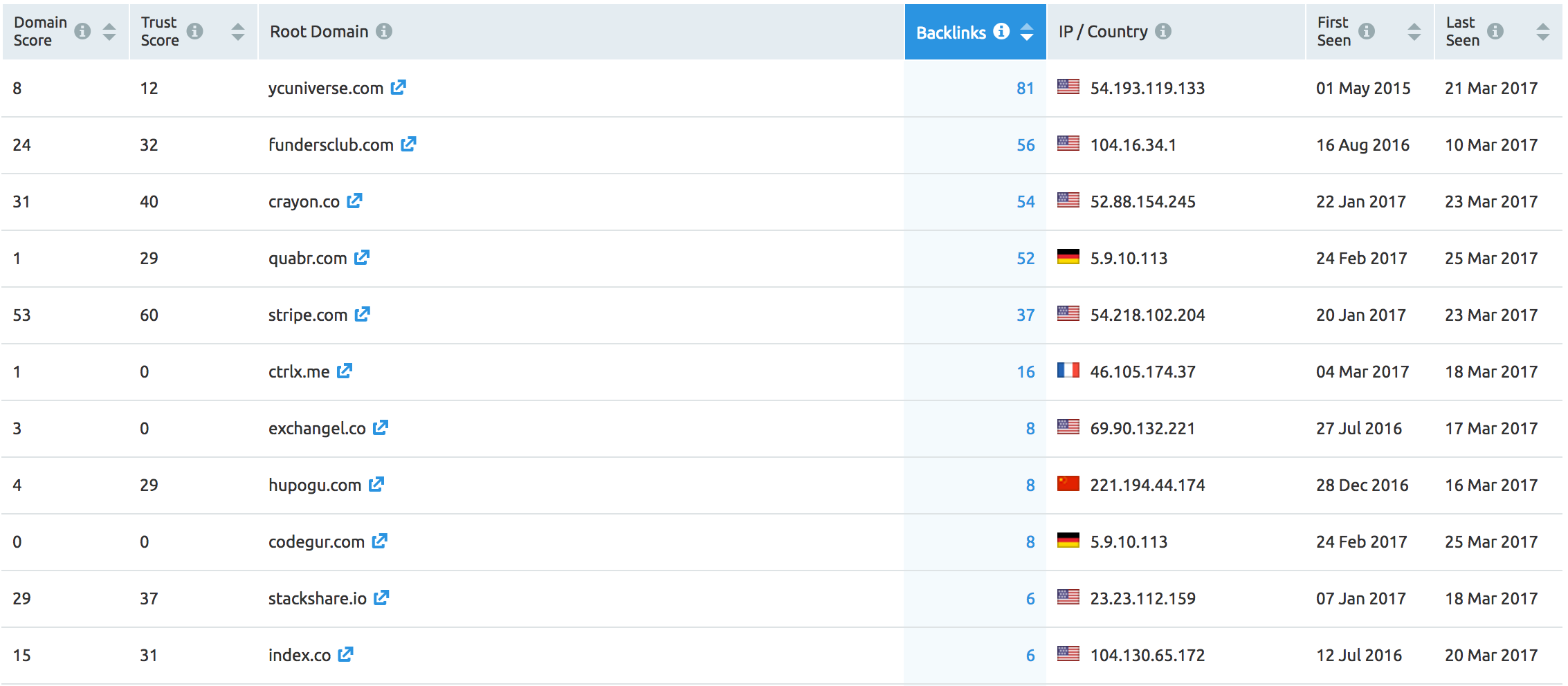
A lot of backlinks from authorities and publishers in the startup world seem like a good idea to me in this example.
Now that we know what your backlink profile should look like, we know what levers to pull. I am not saying ask your users for backlinks like genius because that will get you slapped by Google.
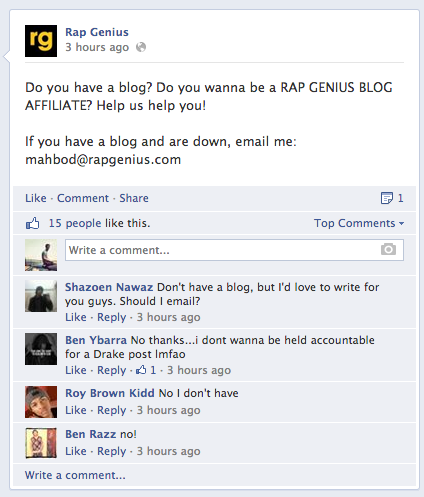
Additional Strategies for Outreach, Guest Posts, Blogging, and VC
Instead, seek contact with journalists at startup oriented publishers like Techcrunch, Venturebeat, Gizmodo, or BusinessInsider. All of these sites want contact with startups. And they are all aware of being a hot source for backlinks, so don’t blow it.
It is easy to smell when someone just wants a link. Journalists want interesting, fresh material. Build a true relationship with them, tell them about your mission and give them the information they need. You won’t have to ask for backlinks. That will happen naturally.
Most publishers have guest article guidelines (simply google [publisher] + guest article). Respecting those when you reach out will double your chances. Focus on writing about your mission and what change you are trying to make in the world. That will get you valuable backlinks and even more important, attention from the right people.
Another smart way is to simply blog about your startup on your site and give people a look behind the scenes. Provide a lot of photo material and tell people that they can take and do whatever they want with it. This provides a platform for other bloggers who want to write about you and will also give natural backlinks.
Your VCand/or business angel(s) and platforms like AngelList and ProductHunt will also provide highly valuable backlinks. Make sure to set up your profiles correctly and don’t change your name or domain unless it’s absolutely necessary. You cannot imagine how many broken links I see on AngelList. Don’t. Do. That. Also, please don’t promote your product on ProductHunt when your site isn’t fully built out.
4. Scale User Acquisition Exponentially
One crucial fact that is often overlooked by startup and SEO folks is that since Google released its Hummingbird update, pages can provide exponential ROI by ranking for many relevant queries — if done right.
Look at Airbnb’s “things to do in” pages, for example:
They target queries like “things to do in San Francisco”, “what to do in San Francisco”, “San Francisco attractions” and so forth. This one page ranks for 160K keywords!

The combined search volume is gigantic! Airbnb is scaling their similar pages massively.


User Intent
These kinds of pages rank so well because they are satisfying the user intent perfectly.
They contain a map that is quick and easy to use, but also a list with more detailed descriptions of the locations. What is almost more important: the content is well-curated. That is what I would want to see when using such a query. Not the same touristy places you find on every other side, but the insider stuff!
Focus on user intent, outstanding content, and easy consumption of information to rank well (+ authority of course). This is what the high-level process looks like to build a construct like Airbnb’s at scale:
Find something you can scale up online
Figure out user intent
Create a small set of test pages
Measure their performance
Refine
Scale up
If your product lives online, good! You will probably not spend a lot of time on step one since you already know what to scale. For you, it will be more about the refinement of those pages before you scale them up. That goes from components and content on the landing pages to snippet design.
Example: Pinterest
You obviously can’t create a handwritten snippet for each landing page, so you will have to work with patterns to optimize your meta-titles and descriptions. Look at Pinterest to understand what I mean:
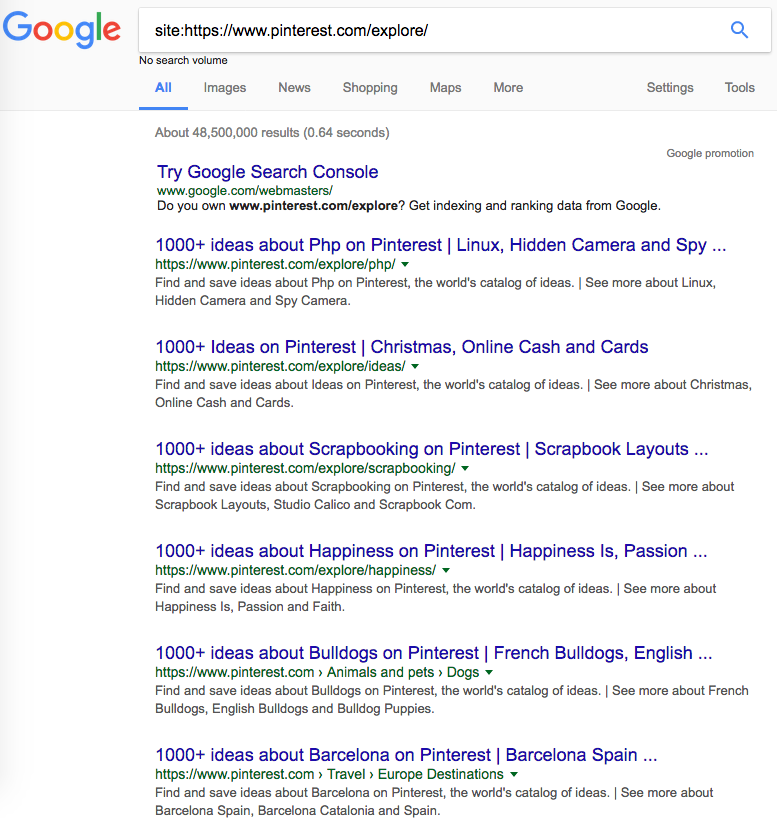
Pinterest gets over 80% of their rankings from the /explore/ directory. Not only have they refined their landing pages very well but also put a lot of effort into their snippets. They fit the user intent, which is mostly inspiration and discovery for Pinterest.
By using the pattern “1000+ ideas about [keyword]” on their titles they stick out on every SERP and address the high volume of ideas users are looking for at that stage. Click Through Rate (from SERPs) is a big, if not the biggest, ranking factor right now. That means paying attention to your snippet pays off.
Their SEO strategy made Pinterest the most successful site in SEO (US + DE) in 2016, by the way.
Microsites
If you are now yelling “But Kevin, I don’t have an online product like Pinterest!”, let me tell you: there is still hope, my lad. When you cannot scale landing pages easily because they are part of your product, your best bet is probably on microsites.
Microsites are clusters of pages that address users in the informative stage of the funnel. They are usually somewhat isolated from the rest of the domain, either by design, navigation, or both. Inside Chanel does a pretty good job with that, for example.

The microsite collected >13K backlinks from >1,5K domains.
I am not speaking about magazines like Red Bulletin or Game Plan A. Those can be sources of SEO growth on their own, but aren’t the most feasible for startups.
A Defined Focused Topic
Microsites have one focused topic. They can be a one-pager, like Simply Business’ guide to CRO or their microsite about the acquisition strategies of the biggest tech giants, but don’t have to be.

This microsite has tons of social shares...
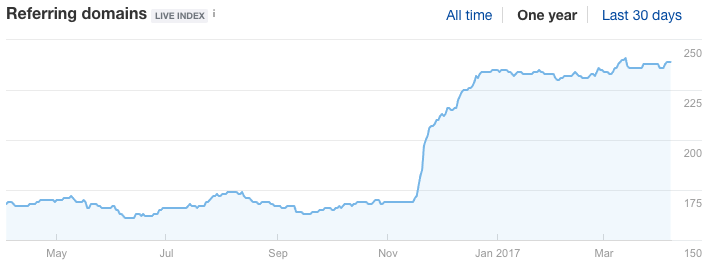
...and successfully attracts backlinks.
Microsites unleash their full power when consisting of many pages. They don’t have to be interactive, but it surely doesn’t hurt. What is more important is that they appear as a closed entity that is not pushing sales too hard. They often have a different design compared to the main site.
Subdomain vs. Directory
There are pros and cons for putting a microsite on a subdomain vs. directory. On a subdomain it is easier to provide an isolated environment. The downside is that you have to make sure to link smartly to the most important pages on your main site since Google sees subdomains as its own entity (“www.” Is also a subdomain). An often better choice is directories since they are regarded as part of the main site.
At Atlassian we have a microsite about “git” with >120 pages, for example.
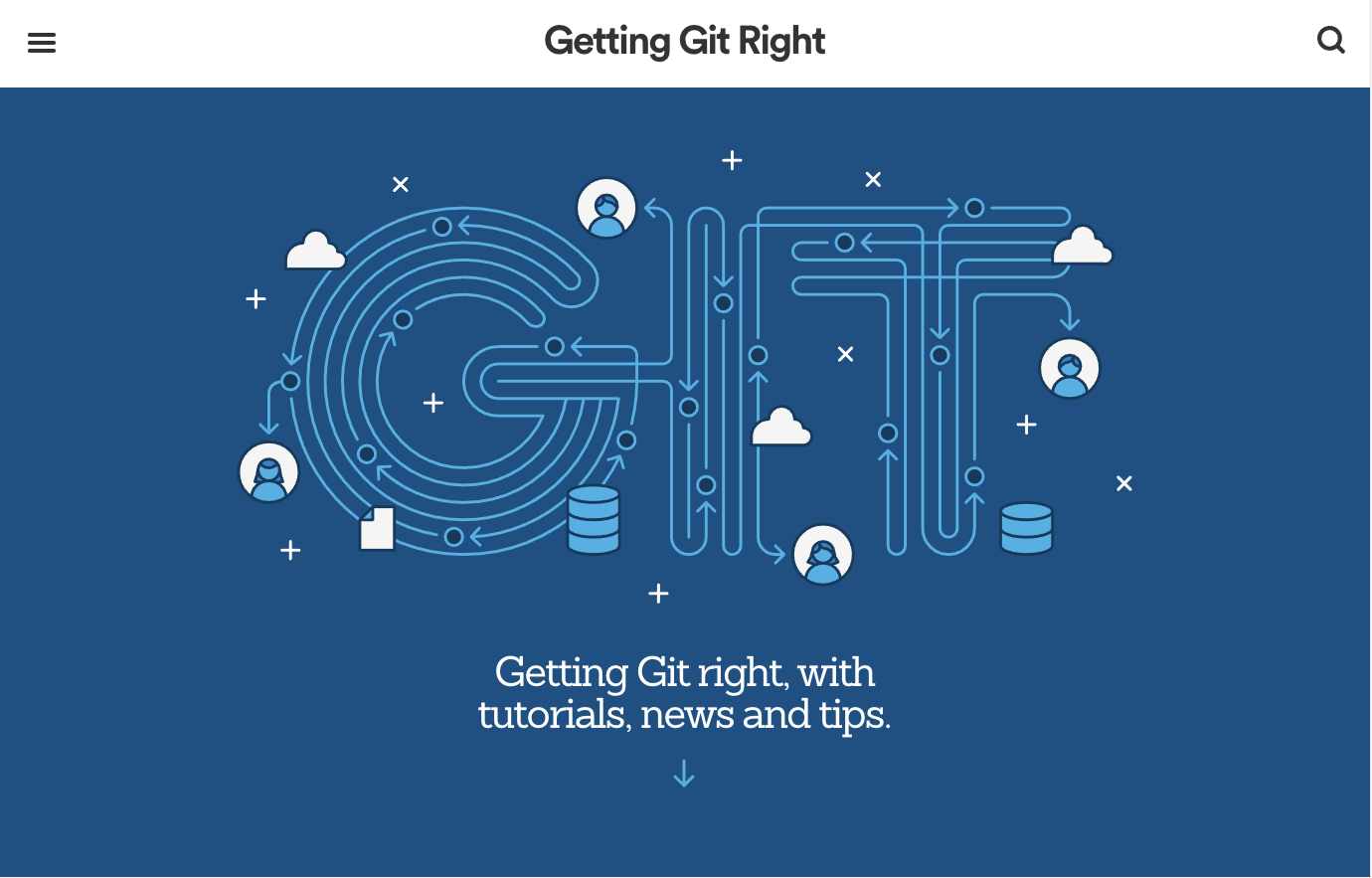
It is our hub to educate our user base, not to sell to them.
Content Funnel
The purpose of microsites is not to convert users, but to support them in the informative stage of the user journey. Instead, being present in the information stage is the first step to lead people all the way through the content funnel.
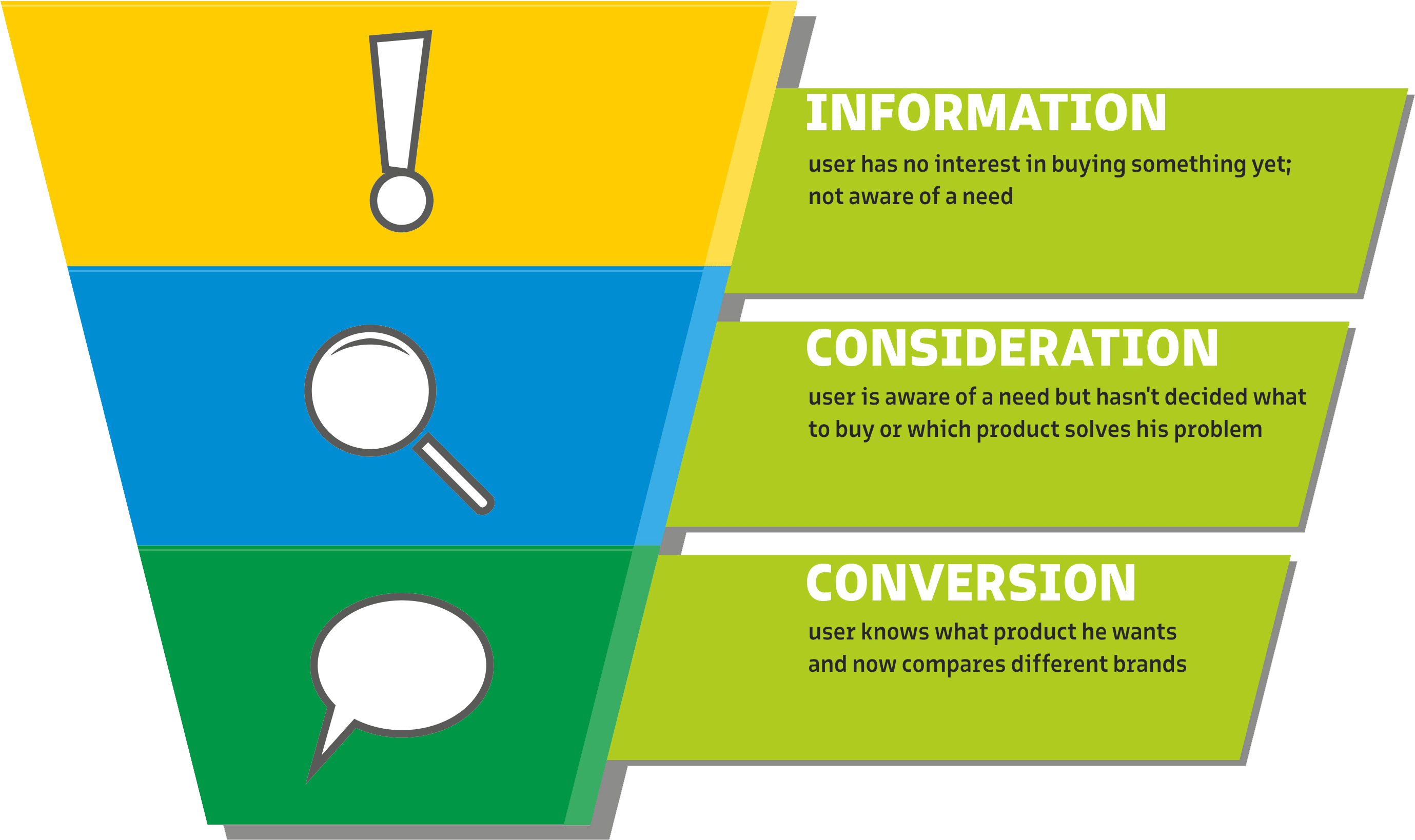
Users are extremely sensitive to being sold and have short attention spans nowadays. It is smarter to provide them value without expecting anything in return before you sell. Separating your content into three categories that each appeal to the information, consideration, and conversion stage makes sure you address the user in every touchpoint of his journey.
5. Focus On the Right SEO Opportunities
Different types of startups require different attention to areas of SEO. Social networks have to focus on other things than SaaS startups. We can roughly cluster SEO into technical optimization, backlinks, and content.
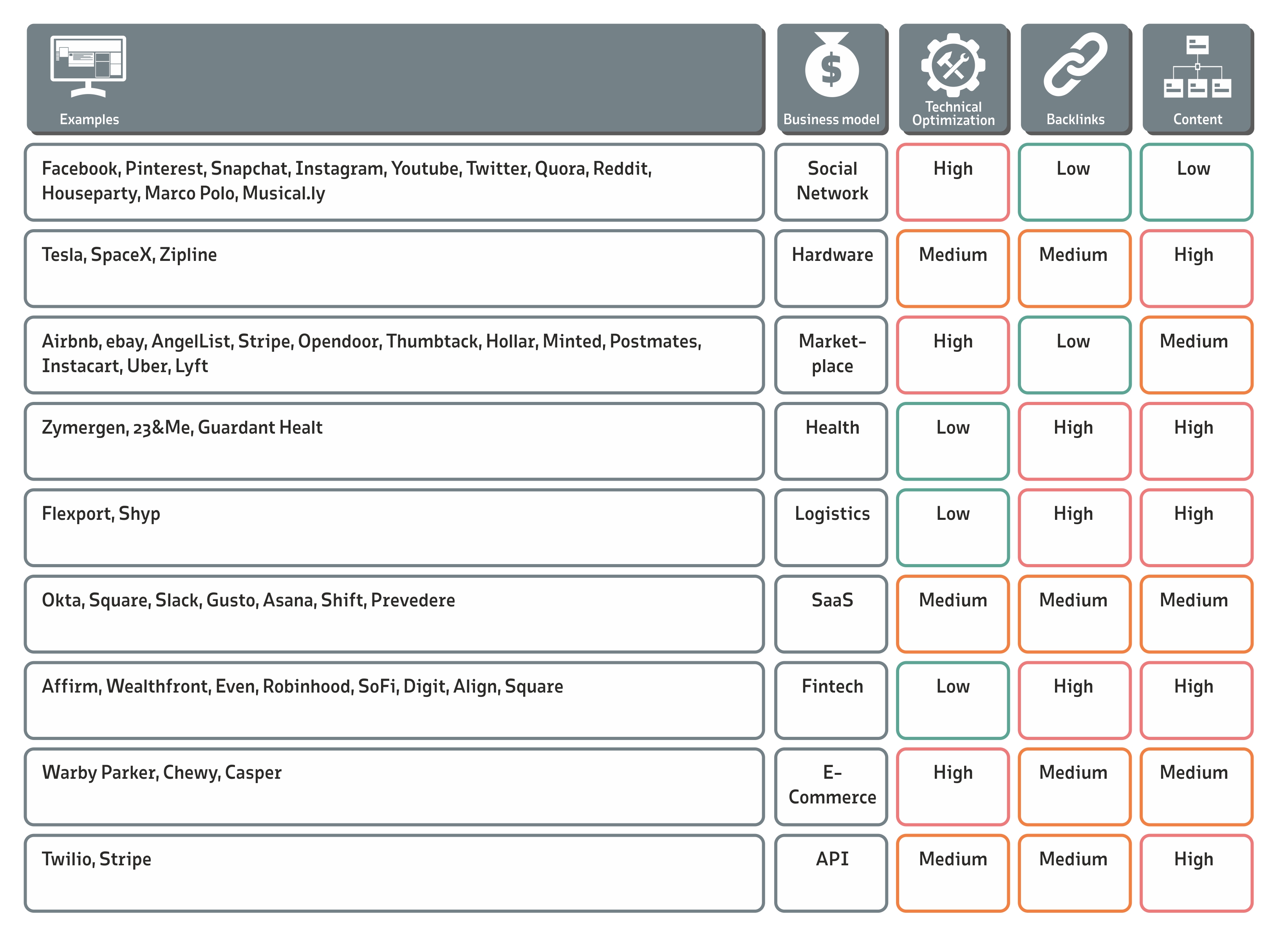
Technical optimization often comes down to improving crawlability. Social networks, e-commerce startups and marketplaces should spend a lot of time thinking about how they can help Google to find all of their pages.
Their problems usually aren are backlinks or content, which their users or products provide, but surfacing these on the SERPs. Their levers are XML sitemaps, internal linking, and hub-pages.
The other end of that spectrum is for health, logistics, and fintech startups that usually don’t consist of easy to scale constructs. They should focus more on creating highly valuable content and earning backlinks. Microsites and blogs are a weapon of choice here. That can and should fall come in combination with linkable assets, like guides, whitepapers, infographics, and other content formats. Round that off with targeted outreach to make sure influencers and hubs in your industry are aware of your great content.
Hardware, SaaS and API startups fall into a middle ground. For them, it makes sense to spread attention equally across the board.
SEO Provides 5 Tremendous Opportunities for Startups
Implementing SEO for startups can gain substantial advantages, for five reasons:
1. The best levers for your startup ultimately depend on your market and business model. The principles we optimize after and the techniques we use might be the same, but the focus is very different.
2. Scale SEO by identifying the best page type to scale, figure out user intent, create a small set of test pages and measure their performance, refine them and then scale up.
3. Authority is a crucial topic every startup needs to think about. Improve it by identifying what backlinks you need and create a strategy to earn them. Support that strategy with targeted outreach that focuses on providing value for others, not pitching yourself.
4. Be aware of the threats to your product by researching what comes up for comparison queries and what questions users have. Build your defense with targeted content and steer the conversation. Ultimately, this feeds back into your product development and helps you to find product-market fit faster.
5. Your reputation is not solely shaped by your website, but how it appears in the search results and what accompanies it. To appeal to users and investors, you need to build strong backup on your own site and others.
My question to you at this point is: what SEO challenges does your startup face?
Innovative SEO services
SEO is a patience game; no secret there. We`ll work with you to develop a Search strategy focused on producing increased traffic rankings in as early as 3-months.
A proven Allinclusive. SEO services for measuring, executing, and optimizing for Search Engine success. We say what we do and do what we say.
Our company as Semrush Agency Partner has designed a search engine optimization service that is both ethical and result-driven. We use the latest tools, strategies, and trends to help you move up in the search engines for the right keywords to get noticed by the right audience.
Today, you can schedule a Discovery call with us about your company needs.
Source:





